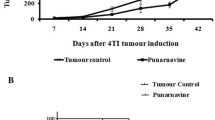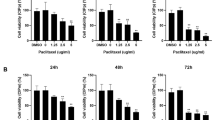Abstract
Purpose
To evaluate the antitumour activity of 5,6-dimethylxanthenone-4-acetic acid (DMXAA), a vascular disrupting agent currently under phase II clinical trials in combination with cancer chemotherapy, in rats bearing chemically induced primary mammary tumours.
Methods
Tumours were induced in female Wistar rats by injection of N-nitroso-N-methylurea at 100 mg/kg subcutaneously. A clinically relevant single dose of DMXAA (1,800 mg/m2) was given to animals when tumours were measurable. Tumour volume, extent of necrosis and cytokine profiles were measured.
Results
Compared with the control group, DMXAA treatment significantly delayed tumour doubling time and extended the time from treatment to euthanasia. Four of five DMXAA-treated animals showed necrosis involving 3.7–41.2% of the area of the tumour section at 24 h compared with none of four control animals (P < 0.028, Chi-square test). Intratumoural levels of TNFα, IL-6, VEGF and IL-1α were increased 4 h after DMXAA treatment.
Conclusions
This study shows for the first time that DMXAA has significant in vivo antitumour activity against non-transplanted autochthonous tumours and in a host species other than the mouse.




Similar content being viewed by others
References
Siemann DW, Bibby MC, Dark GG et al (2005) Differentiation and definition of vascular-targeted therapies. Clin Cancer Res 11:416–420
Kelland L (2005) Targeting established tumor vasculature: a novel approach to cancer treatment. Curr Cancer Ther Rev 1:1–9
Neri D, Bicknell R (2005) Tumour vascular targeting. Nat Rev 5:436–446
Baguley BC (2003) Antivascular therapy of cancer: DMXAA. Lancet Oncol 4:141–148
Siim BG, Lee AE, Shalal-Zwain S et al (2003) Marked potentiation of the antitumour activity of chemotherapeutic drugs by the antivascular agent 5,6-dimethylxanthenone-4-acetic acid (DMXAA). Cancer Chemother Pharmacol 51:43–52
Wilson WR, Li AE, Cowan DS et al (1998) Enhancement of tumor radiation response by the antivascular agent 5,6-dimethylxanthenone-4-acetic acid. Int J Radiat Oncol Biol Phys 42:905–908
Baguley BC, Wilson WR (2002) Potential of DMXAA combination therapy for solid tumors. Expert Rev Anticancer Ther 2:593–603
Rustin G, Bradley C, Galbraith S et al (2003) 5,6-Dimethylxanthenone-4-acetic acid (DMXAA), a novel antivascular agent: phase I clinical and pharmacokinetic study. Br J Cancer 88:1160–1167
Kestell P, Paxton JW, Rewcastle GW et al (1999) Plasma disposition, metabolism and excretion of the experimental antitumour agent 5,6-dimethylxanthenone-4-acetic acid in the mouse, rat and rabbit. Cancer Chemother Pharmacol 43:323–330
Jameson MB, Thompson PI, Baguley BC et al (2003) Clinical aspects of a phase I trial of 5,6-dimethylxanthenone-4-acetic acid (DMXAA), a novel antivascular agent. Br J Cancer 88:1844–1850
Zhou SF, Tingle MD, Kestell P et al (2002) Species differences in the metabolism of the antitumour agent 5,6-dimethylxanthenone-4-acetic acid in vitro: implications for prediction of metabolic interactions in vivo. Xenobiotica 32:87–107
McKeage MJ, Fong P, Jeffery M et al (2006) 5,6-Dimethylxanthenone-4-acetic acid (DMXAA) in the treatment of refractory tumours: a phase I safety study of a vascular disrupting agent. Clin Cancer Res 12:1776–1784
Woon ST, Reddy CB, Drummond CJ et al (2005) A comparison of the ability of DMXAA and xanthenone analogues to activate NF-kB in murine and human cell lines. Oncol Res 15:351–364
Russo J, Russo IH (1996) Experimentally induced mammary tumors in rats. Breast Cancer Res Treat 39:7–20
Field S, Burney IA, Needham S et al (1991) Are transplanted tumours suitable as models for studies on vasculature? Int J Radiat Biol 60:255–260
Izumi Y, di Tomaso E, Hooper A et al (2003) Responses to antiangiogenesis treatment of spontaneous autochthonous tumors and their isografts. Cancer Res 63:747–751
Fenton BM, Lord EM, Paoni SF (2001) Intravascular HBO2 saturations, perfusion and hypoxia in spontaneous and transplanted tumor models. Int J Cancer 93:693–698
Sgadari C, Angiolillo AL, Cherney BW et al (1996) Interferon-inducible protein-10 identified as a mediator of tumor necrosis in vivo. Proc Natl Acad Sci USA 93:13791–13796
Dinney CP, Bielenberg DR, Perrotte P et al (1998) Inhibition of basic fibroblast growth factor expression, angiogenesis, and growth of human bladder carcinoma in mice by systemic interferon-a administration. Cancer Res 58:808–814
Carswell EA, Old LJ, Kassel RL et al (1975) An endotoxin-induced serum factor that causes necrosis of tumours. Proc Natl Acad Sci USA 72:3366–3670
Watanabe N, Niitsu Y, Umeno H et al (1988) Toxic effect of tumor necrosis factor on tumor vasculature in mice. Cancer Res 48:2179–2183
Manda T, Shimomura K, Mukumoto S et al (1987) Recombinant human tumor necrosis factor-alpha: evidence of an indirect mode of antitumor activity. Cancer Res 47:3707–3711
Dvorak HF, Gresser I (1989) Microvascular injury in pathogenesis of interferon-induced necrosis of subcutaneous tumors in mice. J Natl Cancer Inst 81:497–502
Johnson CS, Chang MJ, Braunschweiger PG et al (1991) Acute haemorrhagic necrosis of tumours induced by interleukin-1-alpha—effects independent of tumor necrosis factor. J Natl Cancer Inst 83:842–848
Baban DF, Seymour LW (1998) Control of tumour vascular permeability. Adv Drug Deliv Rev 34:109–119
Joseph WR, Cao Z, Mountjoy KG et al (1999) Stimulation of tumors to synthesize tumor necrosis factor-alpha in situ using 5,6-dimethylxanthenone-4-acetic acid: a novel approach to cancer therapy. Cancer Res 59:633–638
Philpott M, Baguley BC, Ching LM (1995) Induction of tumour necrosis factor-a by single and repeated doses of the antitumour agent 5,6-dimethylxanthenone-4-acetic acid. Cancer Chemother Pharmacol 36:143–148
Ching LM, Goldsmith D, Joseph WR et al (1999) Induction of intratumoral tumor necrosis factor (TNF) synthesis and hemorrhagic necrosis by 5,6-dimethylxanthenone-4-acetic acid (DMXAA) in TNF knockout mice. Cancer Res 59:3304–3307
Pang JH, Cao Z, Joseph WR et al (1998) Antitumour activity of the novel immune modulator 5,6-dimethylxanthenone-4-acetic acid (DMXAA) in mice lacking the interferon-gamma receptor. Eur J Cancer 34:1282–1289
Cao Z, Baguley BC, Ching LM (2001) Interferon-inducible protein 10 induction and inhibition of angiogenesis in vivo by the antitumor agent 5,6-dimethylxanthenone-4-acetic acid (DMXAA). Cancer Res 61:1517–1521
Zhao L, Ching LM, Kestell P et al (2002) The antitumour activity of 5,6-dimethylxanthenone-4-acetic acid (DMXAA) in TNF receptor-1 knockout mice. Br J Cancer 87:465–470
Acknowledgments
The work was supported by New Zealand Cancer Society and the Auckland Medical Research Foundation. We wish to thank Prof. Michael Dragunow for his helpful assistance in imaging analysis (http://www.health.auckland.ac.nz/pharmacology/discovery-1/).
Author information
Authors and Affiliations
Corresponding author
Rights and permissions
About this article
Cite this article
Liu, J.J., Ching, LM., Goldthorpe, M. et al. Antitumour action of 5,6-dimethylxanthenone-4-acetic acid in rats bearing chemically induced primary mammary tumours. Cancer Chemother Pharmacol 59, 661–669 (2007). https://doi.org/10.1007/s00280-006-0321-7
Received:
Accepted:
Published:
Issue Date:
DOI: https://doi.org/10.1007/s00280-006-0321-7




